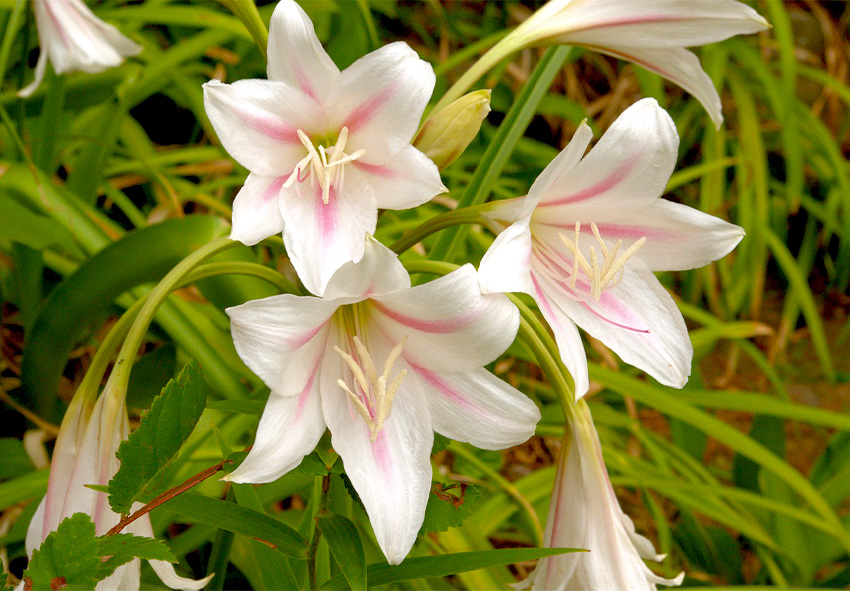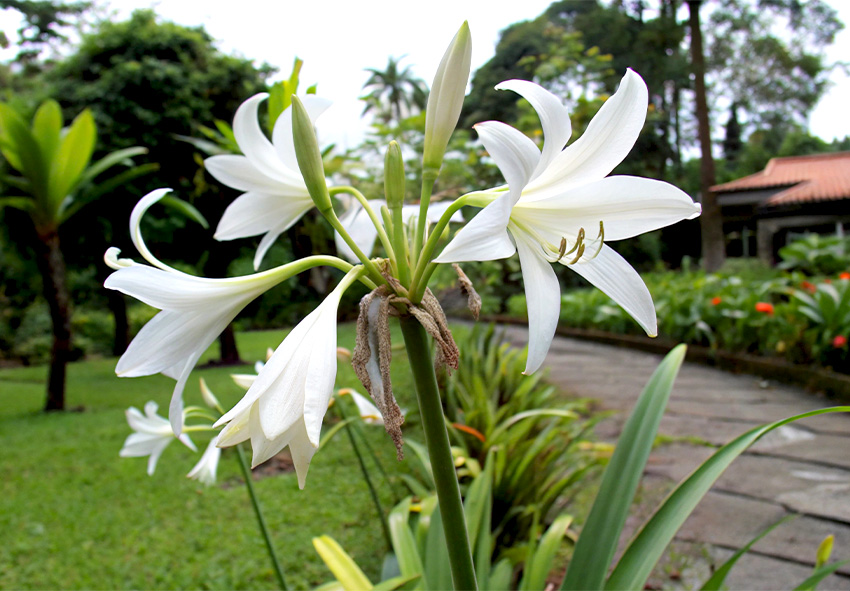Crinum lilies are bold, elegant, and long-blooming plants that add dramatic flair to any landscape. With their large, fragrant flowers and striking foliage, they’re increasingly popular in garden design. This guide explores how to integrate Crinum into your outdoor space for lasting visual impact, whether you’re planning formal borders, tropical beds, or bold container arrangements. Our gardening blog is a perfect place to find all the information you need!
Visual Appeal of Crinum Lilies in Landscape Design

Crinum lilies are not just another flowering bulb — they’re architectural elements in the garden. Their lush, strappy leaves create a tropical feel, while their towering flower stalks emerge with lily-like blooms in shades of pink, white, or red. These plants are perennials in warm zones and serve as focal points due to their height, texture, and strong presence.
Foliage and Flower Characteristics
Crinum lilies offer more than beautiful flowers — they provide consistent interest throughout the growing season. Their foliage resembles that of ornamental grasses but is much bolder, while their flowers appear in trumpet clusters atop tall stalks. Depending on the variety, Crinum may bloom once or several times between spring and fall.
Structural Presence in the Garden
Crinum plants are not just known for their striking blooms — they also serve as powerful architectural elements in garden design. Their tall, strappy foliage and large floral clusters can anchor a planting bed, draw the eye, and create rhythm throughout a landscape. Here are key ways Crinum adds structural presence to your garden:
- Focal Points: Use Crinum as eye-catching centerpieces in flower beds or entryways. Their height and form draw attention and help guide visual flow in the garden.
- Natural Borders: Plant Crinum along pathways or fences to create soft yet defined garden edges with year-round interest.
- Height Variation: The vertical lines of Crinum foliage break up low-growing plantings and add height for a layered garden look.
- Repetition for Cohesion: Repeating Crinum at intervals throughout a landscape brings unity and rhythm, making even eclectic plantings feel intentional.
- Winter Interest: In mild climates, Crinum foliage remains green through winter, providing off-season structure when other perennials go dormant.
Design Applications for Crinum in Garden Settings
Crinum lilies are incredibly versatile and can be used as statement plants or rhythm-setting repeats in various garden themes. Their robust size makes them effective anchors in borders, while their tropical appearance allows them to shine in both modern and lush, layered designs.
Focal Points and Statement Pieces
Plant Crinum in high-visibility areas such as near front doors, along garden gates, or as the centerpiece of flower beds. Their blooms naturally draw attention and make a striking first impression. Position them in front of darker foliage plants to highlight their flowers’ delicate hues.
Designing with Repetition and Rhythm
Repetition of Crinum throughout a border creates a cohesive, rhythmic design. Whether in formal layouts or more naturalistic styles, using the same plant in intervals gives the garden structure and unity. Try spacing them evenly along pathways for a stately effect.
Integrating Crinum in Garden Layouts

Because Crinum thrives in both in-ground beds and large containers, it can be placed in nearly any outdoor design. Whether you’re planning a backyard makeover or a small patio display, Crinum brings texture and beauty to the layout.
Border and Bed Combinations
Pair Crinum with plants that contrast in color and form — like feathery ferns, lavender, or salvia — to create depth and texture. For a more exotic look, combine with tropical perennials like cannas or elephant ears. These combinations boost seasonal appeal and visual harmony.
Container and Courtyard Design
Crinum grows well in containers if provided ample root space and consistent moisture. Use them on patios or flanking entryways for a grand statement. Mix with cascading plants for vertical contrast and a lush, layered look.
Companion Planting for Design Harmony
Selecting the right companion plants can enhance Crinum’s beauty and create a balanced garden scene. Look for partners that complement Crinum’s large size and bloom time. These companions not only elevate the visual appeal of Crinum lilies but also support a cohesive and thriving garden environment:
- Cannas – Their bold leaves and tropical flowers pair perfectly with Crinum’s large stature and create a lush, exotic look.
- Ornamental Grasses – Varieties like Miscanthus or Pennisetum offer fine texture contrast and soft movement against Crinum’s sturdy form.
- Salvia (Sage) – The vertical spires of blue or purple blooms add a cool-tone counterbalance and attract pollinators.
- Hostas – Ideal for partial shade gardens, their broad, patterned leaves echo Crinum’s lush foliage and add visual variety.
- Agapanthus – Both plants share a love for sun and create an elegant pairing with complementary bloom shapes and colors.
- Daylilies (Hemerocallis) – Their overlapping bloom times and grassy foliage make them excellent border companions.
- Elephant Ears (Colocasia or Alocasia) – Dramatic leaves enhance the tropical theme and amplify the textural impact.
- Iris – Especially moisture-tolerant varieties, irises thrive in similar conditions and add graceful flowers to the mix.
Seasonal Coordination
Crinum typically blooms from mid to late summer, so pairing it with spring bulbs and fall bloomers ensures garden interest all year. Integrate plants like tulips, dahlias, and asters to create a continuous seasonal display. Find more seasonal care tips for your plants in our full guide for Crinum.
Design Tips for Specific Garden Types
Crinum’s adaptability makes it a strong design element for various types of gardens — from lush water features to expansive landscapes.
Water Gardens and Damp Areas
Many Crinum species tolerate moist or boggy soil, making them ideal for planting near ponds or in rain gardens. They thrive where many other ornamentals would rot, contributing height and floral drama to wet zones.
Public Spaces and Grand Landscapes
In large-scale designs like estate gardens or parks, Crinum adds grandeur and timeless beauty. Their long lifespan and minimal maintenance make them suitable for public landscapes where bold impact and resilience are key.
Color Schemes and Themes with Crinum

Crinum lilies work well in themed gardens, from tropical escapes to formal European layouts. Their showy flowers and strong presence adapt to multiple aesthetics.
Tropical, Formal, or Cottage Styles
Create an exotic, lush retreat by incorporating Crinum into a tropical-themed garden. With its bold, strappy foliage and dramatic flowers, Crinum fits right in among other tropical plants. Here are some advice for you:
- Features: Bold foliage, vibrant colors, lush textures.
- Crinum Role: Use as a focal plant surrounded by Cannas, Elephant Ears, and Bananas.
- Design Tip: Group Crinums in clusters near water features or large tropical leaves for a dramatic jungle-like vibe.
If you prefer a classic, structured look, Crinum can add elegance and symmetry to your formal garden layout. Its stately flowers work beautifully in refined designs. You may require this tips:
- Features: Symmetry, structured layouts, elegant plantings.
- Crinum Role: Plant in mirrored arrangements along walkways or garden borders.
- Design Tip: Combine with clipped boxwood hedges, topiary, or gravel paths for a refined, classical look.
Crinum brings height and charm to the informal beauty of a cottage garden. Its soft, arching flowers complement the free-flowing mix of old-fashioned blooms. Here are tips for your cottage garden:
- Features: Informal, overflowing beds, mix of flowers and textures.
- Crinum Role: Use as a tall, graceful backdrop to lower-growing perennials like Echinacea and Foxgloves.
- Design Tip: Let Crinum’s large blooms rise above a whimsical mix of flowers for a charming, romantic effect.
Coordinating Bloom Colors
Match Crinum’s pinks and whites with cool blues and purples like salvia or catmint, or create contrast with hot orange and red blooms. Designing with a consistent color palette can create a calming effect, while bold contrasts add energy.
Conclusion
Crinum lilies are powerful tools in garden design — offering structure, color, and tropical flair. Their adaptability across different styles and settings makes them a must-have for gardeners looking to create visual impact. Browse our online store to find premium Crinum bulbs and transform your outdoor space with these stunning statement plants.
Frequently Asked Questions (FAQs) about Crinum in Garden Design
1. What makes Crinum a good choice for garden design?
Crinum is prized for its bold foliage, tall flower stalks, and striking blooms, which make it an excellent focal point in any garden. Its architectural structure adds height and drama, while its resilience and low-maintenance nature make it ideal for both beginner and experienced gardeners.
2. Can Crinum be used in different garden styles?
Yes, Crinum is highly versatile and works well in a variety of garden styles. It enhances the lushness of tropical gardens, brings elegance to formal layouts, and adds charm to cottage-style landscapes. Its adaptability allows it to integrate beautifully with other perennials and ornamental grasses.
3. Can I order Crinum bulbs from your online store?
Yes! Our online store Dutch-bulbs.com offers a curated selection of high-quality Crinum bulbs suitable for various garden designs. Visit our product page to explore different varieties and get tips on how to successfully incorporate them into your landscape.
4. Where should I plant Crinum for the best visual impact?
Plant Crinum in locations where their height and dramatic blooms can be showcased, such as along borders, near water features, or as focal points in flower beds. They also work well when repeated throughout a landscape to create rhythm and cohesion.
5. What plants pair well with Crinum in garden design?
Crinum pairs beautifully with ornamental grasses, daylilies, cannas, and tropical foliage plants. For contrast, combine them with low-growing ground covers or flowering perennials to highlight their height and structure.
Published: 06.06.2025
